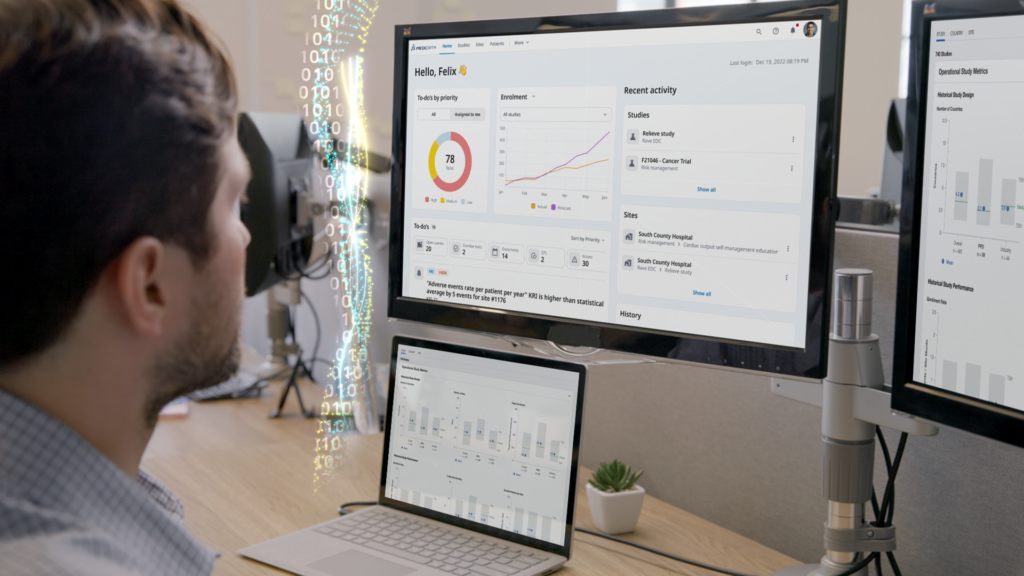eCOA 101: What is Electronic Clinical Outcome Assessment?

In a 2003 BMJ comment article, Ian Kennedy stated, “Patients are experts in their own… experience, feelings, fear, hopes, and desires1.”
This quote underscores why it’s so crucial to get direct feedback from patients to truly understand their health experience. 20 years later, this sentiment is still at the heart of what electronic clinical outcome assessment (eCOA) aims to achieve by making sure that patients’ voices are accurately and effectively incorporated into clinical trials in a meaningful fashion.
Modern medicine is moving away from a paternalistic approach2, and this shift is also impacting how clinical trials are conducted3. Instead of focusing solely on advancing medical science from a top-down perspective, there’s now a stronger emphasis on putting patients first and valuing their contributions. Simultaneously, technological advancements are replacing traditional data capture methods like paper diaries with eCOA, offering greater accuracy and patient engagement. This shift not only improves the patient experience, but also ensures higher-quality data and reduces errors in clinical trials.
Today, eCOA is the mainstream method of capturing clinical outcome assessment data in clinical trials, marking a revolution in how we collect patient data. To fully grasp the significance of this shift away from paper, it’s important to explore the fundamentals of eCOA and the key considerations when implementing it in clinical trials.
Types of Clinical Outcome Assessment
The Food and Drug Administration (FDA) relies heavily on efficacy and safety data to assess new medical interventions, and clinical outcome assessment (COA) data plays an essential role in this process. COA are instruments used to measure and capture how a patient feels and functions4, typically administered as a questionnaire.
Today, there are four major types of COA4:
- Patient Reported Outcome (PRO):
Measurement collected through PRO is based on a report directly from patients about their health status without interpretation by others. Short Form Health Survey (SF-36) is a commonly used PRO that collects health-related quality of life measures from the patient’s perspective5. - Clinician Reported Outcome (ClinRO):
Measurement based on a clinician or a trained healthcare professional after observing a patient’s condition, behavior, or clinical signs. An example is the Columbia-Suicide Severity Rating Scale (C-SSRS) used by clinicians to assess suicide risk6. This is a commonly used eCOA in CNS trials. - Observer Reported Outcome (ObsRO):
Measurement based on reports by someone who regularly observes the patient, such as a parent or a caregiver. Typically used when a patient is unable to report on their own condition. The PedsQL, a measure of health-related quality of life in children and young people, completed by parents, is considered an ObsRO7. - Performance Outcomes (PerfO):
Measurement based on a patient’s performance of a standardized task, assessed by a trained individual or completed by the patient independently. For instance, a patient performing a six-minute walk test (6MWT) in a clinical setting where the distance walked in six minutes is recorded by a clinician, is considered a PerfO8.
Electronic Clinical Outcome Assessment (eCOA)
Traditionally, COA questionnaires were developed and administered using paper forms, but technological advancements in parallel with increasing evidence of benefits using electronic capture have shifted this process to digital platforms, giving rise to electronic clinical outcome assessment (eCOA).
eCOA in clinical trials involves the use of electronic devices such as provisioned mobile devices, tablets, web-based solutions, or patients' own mobile devices (bring your own device, or BYOD) to collect patient data. This approach not only modernizes data collection, but also offers numerous advantages over traditional, paper-based methods.

Advantages of eCOA: The Case for Digital Over Paper
The “parking lot effect” is a phenomenon where patients complete paper-based assessments hurriedly just before their follow-up appointment with their clinician, rather than in a timely manner as defined by the study protocol (e.g. daily). One compelling study by Stone et al. demonstrated this issue, highlighting a significant limitation of traditional paper-based methods in clinical trials9 and drove a lot of the early uptake of electronic data capture. This is because eCOA offers numerous advantages that can achieve more accurate and reliable data collection, as well as streamlining study processes and improving patient engagement and compliance. Some key benefits of eCOA include10:
- Improved Data Quality
eCOAs can be configured to only allow patients to complete forms on their devices within designated time periods (e.g. every morning). Study builders can also use branching logic to avoid conflicting data by guiding patients to skip certain questions based on their previous answers. Additionally, eCOAs automatically record the date and time of each entry, ensuring that the data collected is accurate, complete, and timely, all of which paper COAs cannot achieve. Finally, notifications prompt patients to complete their eCOAs in a timely manner, minimizing the risk of missed data. More complete and higher-quality data can better facilitate the regulatory review process. - Elevated Patient Experience
An experienced eCOA provider well-versed in implementation best practices can offer an intuitive, patient-friendly design that makes it easier for patients to complete their tasks compared to traditional paper methods. Automated workflows and timely notifications reduce the burden on patients, leading to improved compliance and high-quality data collection throughout the trial. Unlike paper methods, eCOAs eliminate the hassle of managing physical forms, reduce errors in data recording, and provide a patient-centric experience that encourages consistent participation. Allowing patients to use their own mobile devices to submit study data further reduces the burden of participation and compliance. - Reduced Secondary Data Entry
eCOA eliminates the need for manual entry of paper-based data, reducing the risk of secondary data entry errors common in paper-based methods. By capturing data directly in digital form, with the data flowing directly into the study EDC, eCOA can maintain data integrity and simplify data management for clinical research sites and sponsors while reducing the time to database lock. - Less Administrative Burden
The administrative burden associated with managing paper forms can be substantial. eCOA systems streamline these processes for study teams, site staff, and patients alike. This includes positively impacting data collection, monitoring, and reconciliation. Automation of these processes significantly reduces the burden on clinical research coordinators and data managers, which leads to significant improvements in operational efficiency. - Cost Savings:
While the upfront investment in eCOA may be more than paper, the long-term savings across the course of a study are significant. eCOA can lower the overall cost of clinical trials by reducing the need for manual data entry, minimizing errors, and speeding up the time to database lock. Additionally, the ability to automate patient data capture processes enhances data quality and compliance rates, potentially leading to faster regulatory approvals and market entry—further enhancing the return on investment.
Best Practices for eCOA Implementation
While the use of technology can be advantageous, challenges arise when it’s not properly implemented in existing workflows and protocols. eCOA implementation covers all processes and tasks involved in setting up an eCOA system and successfully deploying it to a clinical trial to properly capture study data. Successful eCOA implementation requires careful planning and execution, grounded in decades of lessons learned. By adhering to established best practices, sponsors and CROs can maximize the benefits of eCOA while minimizing potential challenges. These practices encompass alignment with eCOA technology providers, ensuring proper licensing of questionnaires, careful attention to trial design, and rigorous testing of study builds—all of which set the study up for a seamless launch and simplified ongoing support. To expand on these key steps11:
- Alignment with eCOA Provider
Trial protocols vary widely, depending on the therapeutic area and disease indications, so it’s critical to choose the right eCOA provider capable of supporting specific trial designs. It’s essential to choose a provider that has the expertise and capabilities to fully support study requirements. These capabilities include not only the technology to build and run the study on user-friendly software, but also the operational support for study setup, ongoing coordination, and help desk services. - Licensing and Translations
Licensing is a crucial step in gaining permission from authors and instrument owners to use their questionnaires in a study. It’s essential to work with the eCOA provider early on to initiate this process. Furthermore, COAs typically need to undergo an appropriate translation process so that they’re both linguistically accurate and culturally relevant. This ensures that the data captured is accurate and meaningful across all countries included in a trial. - Design, Build, and Integrate
The design phase of eCOA implementation involves drafting and finalizing requirements and screens of questionnaires on the eCOA system, which should be reviewed and approved by both the eCOA provider and the sponsor/CRO. Once the design is set, the eCOA provider completes the form build as well as establishes system integrations and data transfer specifications with any involved systems or devices (e.g. EDC and wearables). - User Acceptance Testing (UAT)
User acceptance testing (UAT) is a phase where study teams test the system to verify if it meets their needs and specifications. This step involves collaboration between the eCOA provider and sponsor to outline the UAT process, which follows a rigorous script to make sure all features and use cases are tested, roles assigned, and devices setup. During testing, any issues that arise are tracked and resolved. This step ends with a review and approval of the UAT results to make sure the system is fully ready for a successful go-live. - Training and Support
Training patient and site-staff end-users on the use of eCOA in a trial is critical for minimizing burden and successfully running the study. This training process involves developing and approving customized materials for patients, sites, and study teams, in collaboration with the eCOA provider. A comprehensive training plan ensures all necessary guides and documentation are prepared according to study needs and get into the hands of end users in a timely manner. Additionally, eCOA training content for investigator meetings should be planned and developed to support clear communication and education on eCOA technology.
Considerations When Choosing an eCOA Provider
When choosing an eCOA provider, several factors must be carefully evaluated to make sure their solution aligns with the needs of clinical trials.
- Configurability is key; the platform should be flexible enough to handle everything from simple to highly complex eCOA forms, without having to code from scratch.
- Interoperability with electronic data capture (EDC) and other data systems is important for smooth data integration and efficient management. It will be more advantageous if the provider offers both EDC and eCOA systems in-house, which further streamlines the entire clinical trial lifecycle.
- Ease of use for both patients and sites should be prioritized. The eCOA user experiences should be designed by incorporating their voices into the software development cycle for a patient and site-centric experience. This will ultimately lead to improved patient compliance and clinical trial success.
- Having access to validated instruments ensures that the eCOA provider can support streamlined study start-up time. The concept of a global library where sponsors could easily access eCOA forms is gaining traction, and this capability will be key when selecting forward-thinking eCOA providers.
Future of eCOA
As the clinical trial landscape continues to evolve, it will be crucial for the eCOA providers to stay innovative and forward-thinking, continuously improving the experience for patients, sites, and sponsors. Today, eCOA providers are introducing many transformative technologies that are reshaping the way clinical trials are conducted. For instance, to complement eCOA’s subjective data, the integration of wearables will enable continuous, real-time, objective health data collection, allowing for a comprehensive view of patient outcomes12. As trials become more decentralized, sensors and eCOA will offer patients the flexibility to participate from home, broadening accessibility and convenience. AI-driven data analysis will also unlock new possibilities, enhancing decision-making and enabling datasets to be leveraged for a wider range of applications.

Conclusion
Incorporating eCOA into clinical trials represents a shift away from traditional ways of conduct, aligning with the growing emphasis on patient-centric research. The benefits of eCOA are clear: it improves data quality, patient and site experiences, and operational efficiency. By following best practices throughout the clinical trial lifecycle, sponsors can maximize these advantages. As trials continue to evolve with advancements in technology and a shift towards decentralized models, eCOA remains crucial in capturing the true patient voice and driving medical advancements forward.
Consider eCOA for your clinical trials to improve data quality and patient engagement. Learn more about COA clinical trials.
References
-
- Kennedy I. (2003). Patients are experts in their own field. BMJ (Clinical research ed.), 326(7402), 1276–1277. https://doi.org/10.1136/bmj.326.7402.1276
- Drolet, B.C., & White, C.L. (2012). Selective Paternalism. Virtual Mentor, 14(7), 582-588. American Medical Association Journal of Ethics.
- Staley, A. (2022). Making clinical research better for patients with patient centricity by design. Medidata. https://assetlibrary.medidata.com/m/4b009d28292ea96f/original/Whitepaper-Patient-Centricity-by-Design-Aug-23.pdf
- FDA. Clinical Outcome Assessment (COA): Frequently Asked Questions. FDA.gov. December 2020. Accessed July 19, 2024. https://www.fda.gov/about-fda/clinical-outcome-assessment-coa-frequently-asked-questions#COADefinition
- Ware, J. E., Jr, & Sherbourne, C. D. (1992). The MOS 36-item short-form health survey (SF-36). I. Conceptual framework and item selection. Medical care, 30(6), 473–483.
- Posner, K., Brown, G. K., Stanley, B., Brent, D. A., Yershova, K. V., Oquendo, M. A., Currier, G. W., Melvin, G. A., Greenhill, L., Shen, S., & Mann, J. J. (2011). The Columbia-Suicide Severity Rating Scale: Initial validity and internal consistency findings from three multisite studies with adolescents and adults. American Journal of Psychiatry, 168(12), 1266-1277. https://doi.org/10.1176/appi.ajp.2011.10111704
- Varni, J. W., Seid, M., & Kurtin, P. S. (1999). Pediatric health-related quality of life measurement technology: A guide for health care decision makers. Journal of Clinical Outcomes Management, 6(1), 33-40.
- Holland, A. E., Spruit, M. A., Troosters, T., Puhan, M. A., Pepin, V., Saey, D., McCormack, M. C., Carlin, B. W., Sciurba, F. C., Pitta, F., Wanger, J., MacIntyre, N., Kaminsky, D. A., Culver, B. H., Revill, S. M., Hernandes, N. A., Andrianopoulos, V., Camillo, C. A., Mitchell, K. E., Lee, A. L., Hill, C. J., & Singh, S. J. (2014). An official European Respiratory Society/American Thoracic Society technical standard: Field walking tests in chronic respiratory disease. European Respiratory Journal, 44(6), 1428-1446. https://doi.org/10.1183/09031936.00150314
- Stone, A. A., Shiffman, S., Schwartz, J. E., Broderick, J. E., & Hufford, M. R. (2002). Patient non-compliance with paper diaries. BMJ, 324(7347), 1193-1194. https://doi.org/10.1136/bmj.324.7347.1193
- Paul O’Donohoe, David S. Reasner, Sarrit M. Kovacs, Bill Byron, Sonya Eremenco, Alexandra I. Barsdorf, Valdo Arnera, Stephen Joel Coons, Updated Recommendations on Evidence Needed to Support Measurement Comparability Among Modes of Data Collection for Patient-Reported Outcome Measures: A Good Practices Report of an ISPOR Task Force, Value in Health, Volume 26, Issue 5, 2023.
- Critical Path Institute. (2021). eCOA Process Workflow [PDF]. https://media.c-path.org/wp-content/uploads/20240427173144/GBTI_eCOA_Process_Workflow_v1.pdf
- 2021. Advancing Decentralized Clinical Trials Through a Unified Approach to eCOA and Digital Health Technologies - Uniting Objective Technology-acquired Data with Subjective Clinical Outcomes Data Requires a Fresh Perspective. Medidata. https://assetlibrary.medidata.com/m/4eb8717161b4297b/original/Advancing-Decentralized-Clinical-Trials-Jun-21.pdf
Contact Us
